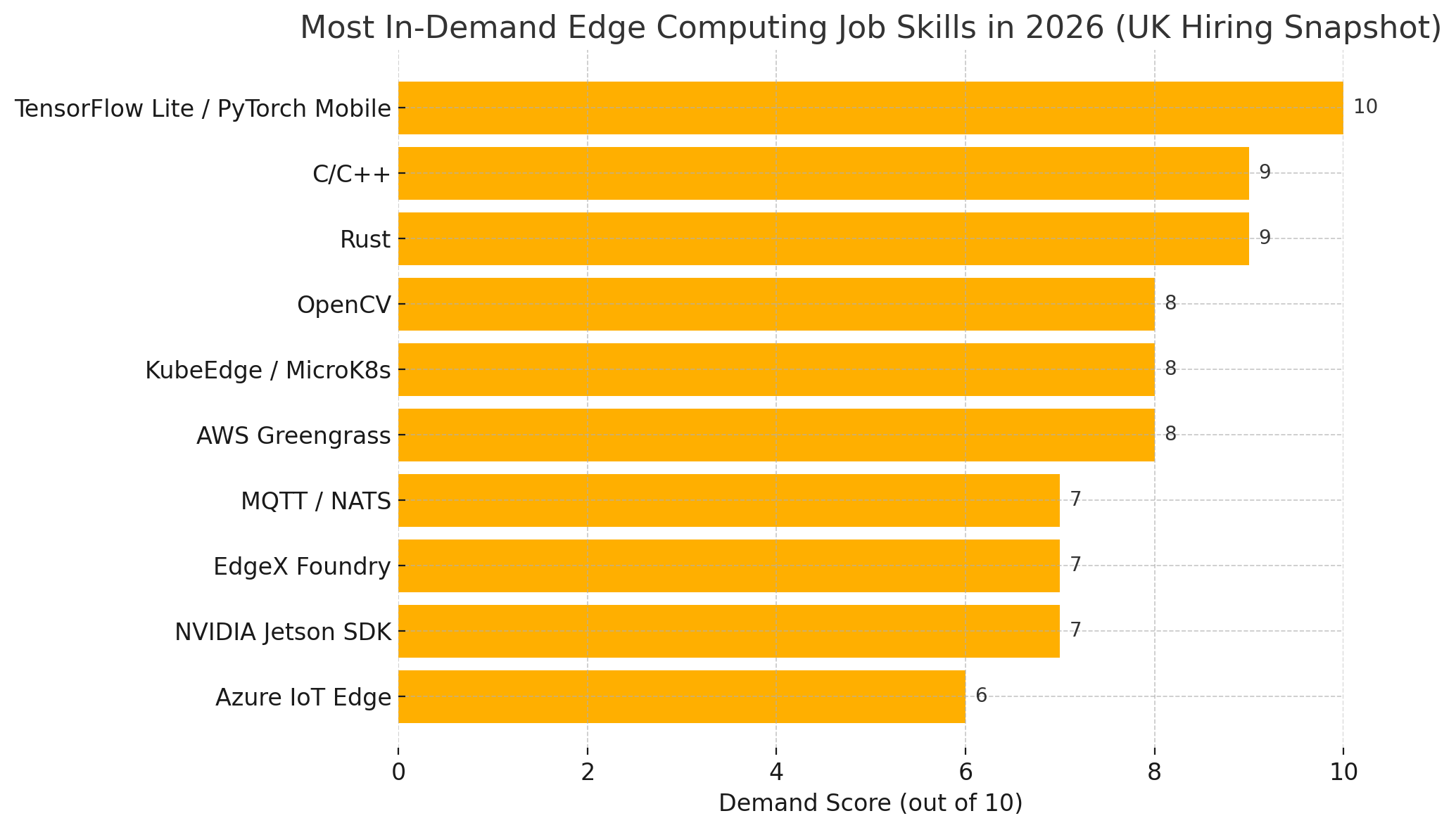
Edge Computing Jobs Skills Radar 2026: Emerging Frameworks, Tools & Technologies to Learn Now
Edge computing is reshaping how we process data—bringing computation closer to devices, sensors, vehicles, and factories. In 2026, the UK’s edge computing landscape is booming, driven by autonomous systems, IoT, 5G, and AI workloads that can’t wait on cloud latency.
Welcome to the Edge Computing Jobs Skills Radar 2026—a forward-looking guide to the tools, frameworks, platforms, and programming languages that are powering the UK’s most in-demand edge computing jobs. Whether you’re building smart cameras, working on industrial automation, or deploying microservices to the edge, this radar will keep your skills sharp and relevant.
Why Edge Computing Skills Are Surging in 2026
In the UK, edge demand is rising across:
Autonomous vehicles
Industrial automation (Industry 4.0)
Telecom & 5G infrastructure
Healthcare & wearable tech
UAVs & defence
The edge is where real-time meets real-world—and employers need professionals who understand not just embedded software, but AI optimisation, edge-cloud architectures, and secure OTA updates.
Top Programming Languages for Edge Computing in 2026
1. C/C++
What it is: The foundation of embedded systems, real-time control, and driver programming.
Why it matters: Required for firmware, RTOS applications, sensor integration and low-latency applications.
Used by: Arm, BAE Systems, Dyson, microcontroller-based startups.
Roles: Embedded Systems Engineer, Firmware Developer, IoT Device Engineer.
Skills to pair: UART/I2C/SPI protocols, FreeRTOS, memory debugging, real-time profiling.
2. Rust
What it is: A memory-safe systems programming language.
Why it matters: Replacing C++ in safety-critical and secure embedded environments.
Used by: Oxbotica, embedded AI startups, drone firmware contributors.
Roles: Embedded Rust Developer, Robotics Systems Engineer.
Skills to pair: Cargo, WASM for edge web apps, async control, low-level libraries.
3. Python
Where it fits: Prototyping, edge AI inference, computer vision and scripting device behaviour.
Used by: NVIDIA Jetson SDK, Raspberry Pi edge systems, OpenCV-based platforms.
Roles: Edge AI Developer, Vision Engineer, Rapid Prototyper.
Skills to pair: OpenCV, TensorFlow Lite, ONNX Runtime, FastAPI.
4. Go (Golang)
Why it matters: Used in lightweight services, edge orchestrators and REST/gRPC-based control systems.
Used by: Cloudflare, edge gateway startups, microservice infrastructure teams.
Roles: Edge Infrastructure Developer, Network Software Engineer.
Skills to pair: microservices, gRPC, MQTT, REST APIs.
5. JavaScript / WebAssembly (Wasm)
Use case: UI, control dashboards, edge-browser logic, and web visualisation.
Used by: Drone telemetry tools, remote robotics UI, edge browser systems.
Roles: Edge Web Engineer, Visualization Developer.
Essential Frameworks, SDKs & Platforms
1. TensorFlow Lite / PyTorch Mobile
What it is: Lightweight machine learning frameworks for on-device inference.
Why it matters: Enables AI workloads without needing cloud round trips.
Used by: Vision-based robotics, smart cameras, AR devices.
Roles: Edge AI Developer, ML Engineer.
Skills to pair: Quantisation, pruning, ONNX conversion, Jetson deployment.
2. OpenCV
What it is: The most-used computer vision library.
Why it matters: Real-time edge use cases rely on efficient image and video processing.
Used by: Drones, surveillance, industrial vision systems.
Roles: Computer Vision Engineer, Edge Vision Specialist.
Skills to pair: YOLOv7, video streaming, object detection, CUDA acceleration.
3. KubeEdge / MicroK8s / k3s
What it is: Lightweight Kubernetes variants for edge clusters.
Why it matters: Enables container orchestration on ARM boards, gateways, and mobile edge.
Used by: Edge cloud platforms, IoT operators, telco equipment providers.
Roles: Edge DevOps Engineer, Kubernetes Specialist.
Skills to pair: Helm, CRDs, Prometheus, containerd.
4. NVIDIA Jetson SDK / DeepStream
What it is: NVIDIA’s hardware and software stack for edge AI.
Why it matters: Popular for drones, industrial cameras, autonomous robotics.
Used by: Robotics startups, delivery drones, defence vision systems.
Roles: Jetson AI Developer, Embedded AI Engineer.
Skills to pair: CUDA, TensorRT, CSI cameras, DeepStream pipelines.
5. EdgeX Foundry
What it is: Open-source edge platform for industrial IoT.
Why it matters: Bridges sensors, gateways, and apps in real-time environments.
Used by: Manufacturing, utilities, IIoT system integrators.
Roles: IoT Solutions Engineer, Edge Platform Developer.
Skills to pair: MQTT, Modbus, REST APIs, device services.
Cloud-to-Edge Tools, Messaging & Connectivity
▸ AWS IoT Greengrass / Azure IoT Edge
What it is: Extensions of cloud platforms to the edge.
Why it matters: Supports AI inference, secure updates, and device management.
Used by: Healthcare, logistics, smart energy.
Roles: Edge Architect, DevOps for IoT.
Skills to pair: Lambda functions, Pub/Sub, certificate rotation, OTA management.
▸ MQTT / NATS / ZeroMQ
What it is: Lightweight messaging protocols for constrained devices.
Why it matters: Enables efficient event-driven data movement.
Used by: Edge sensors, control systems, smart home devices.
Roles: Messaging Architect, Protocol Developer.
▸ 5G Private Networks / TSN / Edge Mesh
Why it matters: Enabling low-latency, high-bandwidth infrastructure for factory and campus-based edge compute.
▸ OPC-UA / CAN Bus / Serial Protocols
Used in: Industrial control systems, robotics, transport automation.
Security, Compliance & Management at the Edge
▸ Secure Boot & TPM
Ensures hardware is booting trusted firmware and preventing tampering.
▸ Device Identity & Zero Trust Access
Tools: SPIFFE, Azure Entra ID for devices, Zero Trust proxies.
▸ Edge Firewall & Monitoring Tools
UFW, Falco, syslog collectors, Prometheus for remote metrics.
Most In-Demand Edge Computing Job Skills in 2026 (UK Hiring Snapshot Forecast)
Let’s visualise the most requested tools, frameworks & platforms UK employers want from edge computing candidates:
 How to Future-Proof Your Edge Computing Career in 2026
How to Future-Proof Your Edge Computing Career in 2026
Understand the Full StackFrom embedded firmware to AI deployment, edge engineers must work across layers.
Focus on Performance & SecurityLearn Rust, secure boot workflows, and minimal-footprint orchestration.
Work with Real DevicesSet up Raspberry Pi, NVIDIA Jetson, or other edge hardware to test deployments.
Join Edge-Focused CommunitiesEngage with LF Edge, UK5G, Arm Developer Community, and ROS/robotics meetups.
Where to Find Edge Computing Jobs in the UK
🛰 Visit www.edgecomputingjobs.co.uk for the latest UK-based roles in embedded systems, AI at the edge, industrial IoT, 5G, cloud-to-edge platforms & smart mobility.
Conclusion: Your Edge Computing Toolkit for 2026
The edge computing job market is one of the fastest-evolving in UK tech. In 2026, success means balancing hardware familiarity, network awareness, and lightweight software fluency. The ability to optimise AI models for latency and reliability at the edge is becoming gold dust for employers.
Use this Edge Computing Jobs Skills Radar 2026 to sharpen your focus—and return each year as we update the radar to reflect the tools driving real UK job market demand.
Subscribe to our newsletter for curated edge job alerts, expert interviews & tech briefings from across the UK.


